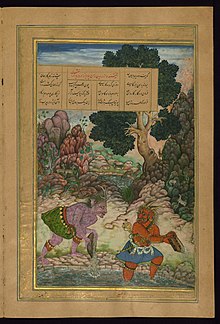
Back Дэў (армянская міфалогія) Byelorussian Дэў (армянская міталёгія) BE-X-OLD Dev (Mythologie) German دیو Persian Դև (դիցաբանություն) Armenian დივი Georgian Dev (mythologie) Dutch Дэв (армянская мифология) Russian
 King Solomon and Two Demons in Persian miniature | |
| Grouping | Mythical creature |
|---|---|
| Folklore | Persian mythology Armenian mythology Albanian mythology Turkish mythology |
| Country | Iran, Armenia, Albania, Turkey |
Div or dev (Persian: Dīv/Dēw: دیو) (with the broader meaning of demons or fiends) are monstrous creatures within Persian lore.[1] Most of their depictions derive from Persian mythology, integrated to Islam and spread to surrounding cultures including Armenia, Turkic countries[2] and Albania.[3] Despite their Persian origins, they have been adapted according to the beliefs of Islamic concepts of otherworldly entities.[4](pp 37) Although they are not explicitly mentioned within canonical Islamic scriptures, their existence was well accepted by most Muslims just like that of other supernatural creatures.[5](p 34) They exist along with jinn, peri (fairies)[6] and shayatin (devils) within South and Central Asian demon-beliefs.[7]
They are described as having a body like that of a human, only of gigantic size, with two horns upon their heads and teeth like the tusks of a boar. Powerful, cruel and cold-hearted, they have a particular relish for the taste of human flesh.[8][full citation needed] Some use only primitive weapons, such as stones: others, more sophisticated, are equipped like warriors, wearing armour and using weapons of metal. Despite their uncouth appearance – and in addition to their great physical strength – many are also masters of sorcery, capable of overcoming their enemies by magic and afflicting them with nightmares.[9]
Their origin is disputed, although it may lie in the Vedic deities (devas) who were later demonized in the Persian religion (see daeva). In Ferdowsi's tenth-century Shahnameh, they are already the evil entities endowed with roughly human shape and supernatural powers familiar from later folklore, in which the divs are described as ugly demons with supernatural strength and power, who, nonetheless, may sometimes be subdued and forced to do the bidding of a sorcerer.
- ^ Friedl, E. (2020). Religion and Daily Life in the Mountains of Iran: Theology, saints, people. United Kingdom: Bloomsbury Publishing. p. 85.
- ^ Karakurt, Deniz (2011). Türk Söylence Sözlüğü [Turkish Mythological Dictionary] (PDF). p. 90. ISBN 9786055618032. (OTRS: CC BY-SA 3.0)
- ^ Elsie, Robert (2007). "Albanian Tales". In Haase, Donald (ed.). The Greenwood Encyclopedia of Folktales and Fairy Tales. Vol. 1: A–F. Westport, CT: Greenwood Publishing Group. p. 24. ISBN 9780313049477. OCLC 1063874626.
- ^ Abedinifard, Mostafa; Azadibougar, Omid; Vafa, Amirhossein, eds. (2021). Persian Literature as World Literature. Literatures as World Literature. USA: Bloomsbury Publishing. pp. 40–43. ISBN 978-1501354205, ISBN 9781501354205
- ^ Nünlist, Tobias (2015). Dämonenglaube im Islam [Islamic Belief in Demons] (in German). Walter de Gruyter GmbH & Co KG. ISBN 978-3-110-33168-4.
- ^ Shamanism and Islam: Sufism, Healing Rituals and Spirits in the Muslim World. (2017). Vereinigtes Königreich: Bloomsbury Publishing. p. xxx
- ^ South Asian Folklore: An encyclopedia. United Kingdom: Taylor & Francis. 2020.
- ^ Reza Ebrahimil, Seyed; Bakhshayesh, Elnaz Valaei. Manifestation of Evil in Persian Mythology from the Perspective of the Zoroastrian Religion. p. 7.
- ^ "Dīv". Encyclopædia Iranica. Dārā(b)–ebn al-Aṯir. Vol. VII, fasc. 4. 28 November 2011 [15 December 1995]. pp. 428–431. Retrieved 25 February 2020.
© MMXXIII Rich X Search. We shall prevail. All rights reserved. Rich X Search